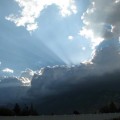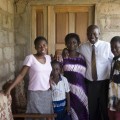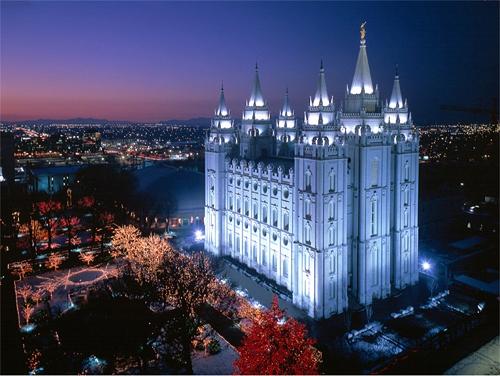The construction workers building the new Philadelphia Pennsylvania Mormon Temple are following an unusual set of rules. Praised by the mayor of the city for the 300 construction jobs and a boost to tourism, as well as improvements to an area the city hopes to revitalize, the 60,000 square foot project is being built by union workers, so far all non-Mormon, who have agreed to follow a strict set of rules. (See Philly’s LDS site: No smoking, swearing, caffeine, Seattle PI., November 25, 2013.)
The workers are not allowed to smoke, drink, have a cup of coffee, or swear while on the construction site. Workers who wish to use those substances cross the street during breaks. Each morning the foremen and project managers meet to go over the day’s plans and to have a prayer. The prayer is optional for all contractors. So are the one hundred homemade cookies the couple overseeing the project and the visitor’s center bake for the contractors every Wednesday.
Mormon Temples: Sacred Ground
The Mormons consider the land on which the temple is being built to be sacred ground and even while it is being built, it must be treated as such. The land was blessed with a special prayer during the groundbreaking, making it holy ground even before the temple is dedicated as a house of God. Mayor Nutter of Philadelphia noted that it is the cleanest construction site he’s ever seen. The walks and streets are swept every day and the fences are free of graffiti. The workers are proud of their project and the high quality of the work, and so they have no complaints about the rules they follow. There was no difficulty lining up workers.
The reason tobacco, alcohol, and coffee are prohibited is that the Mormons practice a code of health known as the Word of Wisdom. The Word of Wisdom was revealed through revelation to Joseph Smith, the first prophet in modern times, in 1833. It outlines a pattern for living in good health.
It is most famous for its “dont’s.” The code prohibits alcohol, coffee, tea, and tobacco. Although many people believe caffeine is prohibited, the code actually doesn’t mention caffeine. It refers only to “hot drinks,” which, at the time of the revelation, meant coffee and tea. Many Mormons do avoid caffeine because of its addictive properties, but it is not required. Mormons are also expected to avoid anything that is known to be dangerous or addictive, including illegal drugs or the inappropriate use of prescription drugs.
Less well-known is that the code also lists things we should do in order to be healthy. While some of these teachings seemed unusual at the time, science has since caught up with the revelation and now advocates this type of eating.
The Word of Wisdom encourages the use of fruits and vegetables in season. Meat is permitted, but sparingly. The code also encourages eating grains like wheat, rice, and oats, and getting sufficient sleep.
Those who keep this code are promised wisdom, knowledge, energy, and good health. Rather than seeing them as restrictive, Mormons believe that following this code actually increases their freedom. They have the health and energy to do the things they want to do and are free of the challenges that come from addictions.
Heber J. Grant, who was the Mormon prophet from 1918 to 1945, began to emphasize the importance of avoiding alcohol and tobacco among Mormons, building their reputation for not using them. This was long before science had noticed the link between tobacco and cancer. People were less concerned about the impact of alcohol on health and behavior and on the addictive nature of it. Even the addictive nature of coffee and tea was less-well understood. Today, of course, we understand the great dangers of these substances and when science began to warn against them, Mormons were already safe. Many today struggle to overcome addictions to these substances.
People who become Mormon must give up these substances prior to baptism. While it is very difficult for many, some have been able to do so once they ask God for help or when they understand the power of the atonement to help them regain control over their own lives. Mormons offer a twelve-step program that helps people to overcome addictions of any kind.
Learn about the Mormon addiction recovery program.
Visit the Philadelphia Mormon Temple Site
The Mormon temple is very special to the Mormons in the area. Many make regular trips to watch the progress of the construction project. A recent newspaper article featured a group of teenage girls who walk thirteen miles once a year to the site. The trip is organized by their leaders, capable and confident women who want these girls to understand they are far more than hairstyles, makeup and fashion. They hope the challenge of taking such a long hike—collecting trash as they walk—will show them they can do difficult and meaningful things all their lives.
Read about the annual pilgrimage to the Mormon temple in Philadelphia.
When the temple is built, the girls who are at least fourteen will be able to go inside a small portion of it to provide service. When they are adults, they will have full privileges inside. Mormon temples are open to the public during an open house period. Then they are dedicated and only worthy Mormons are permitted inside. This preserves the sacredness of the buildings. All who are inside understand the sacred—not secret—ordinances and teachings that occur inside.
The Difference between Temples and Chapels
There is a visitor’s center on the site of the Philadelphia Mormon temple. It is a trailer and is temporary during the time the temple is being built. Visitors are welcome to stop in for a non-pressure visit and find out what temples are all about—and if you show up on Wednesday, there might be a cookie or two left over.
Visit the Philadelphia Mormon temple site.
About Terrie Lynn Bittner
The late Terrie Lynn Bittner—beloved wife, mother, grandmother, and friend—was the author of two homeschooling books and numerous articles, including several that appeared in Latter-day Saint magazines. She became a member of the Church at the age of 17 and began sharing her faith online in 1992.





